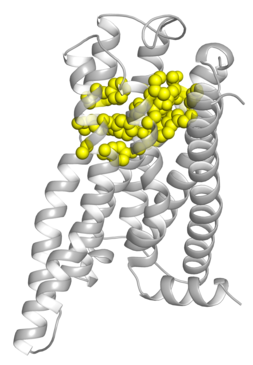Taste receptors for bitter substances are not only observed on the tongue but also in cells outside of the oral cavity. Extraoral bitter taste receptors may also serve as endogenous bile acid sensors, according to a new study from the Leibniz Institute for Food Systems Biology at the Technical University of Munich.
 Model of the bitter taste receptor TAS2R14. The side chain residues relevant for ligand binding are shown in yellow. Image Credit: Antonella Di Pizio
Model of the bitter taste receptor TAS2R14. The side chain residues relevant for ligand binding are shown in yellow. Image Credit: Antonella Di Pizio
This finding suggests that endogenous substances, in addition to food components, may have impacted the evolution of bitter taste receptors. Moreover, the study offers novel approaches for investigating the health effects of food constituents involving extraoral bitter taste receptors.
Bitter taste receptors function as taste sensors, detecting and avoiding potential toxins in food. Recent research indicates that bitter taste receptors can be found on lung, brain, and gastrointestinal tract cells, as well as blood and sperm cells. This suggests that there are additional, less well-studied receptor functions in the body, particularly since the human body produces bitter substances.
Based on these results, the question of whether bitter taste receptors evolved as taste receptors or as endogenous sensors interacting with endogenous bitter substances arises. The latter, of course, would necessitate endogenous substance concentrations in the corresponding body fluids being sufficient to trigger endogenous bitter taste receptors on extraoral tissues and cells.
Bile Acids are Endogenous Bitter Substances
Bile acids are an example of endogenous bitter substances that are found in a variety of body fluids. As a result, researchers at the Leibniz Institute in Freising, Germany, guided by Maik Behrens, researched which of the 25 human bitter taste receptor types respond to physiologically relevant bile acid concentrations. The group employed an established cellular test system and merged functional experiments with molecular modeling approaches to achieve this goal. Primary, secondary, tertiary, and conjugated bile acids were among the eight bile acids tested.
According to the findings, five bitter taste receptor types respond to the bile acids tested.
In this context, the measured activation thresholds of the receptors matched very well the bile acid concentrations reported for human body fluids in the literature.”
Florian Ziegler, Doctoral Student, Leibniz Institute for Food Systems Biology, Technical University of Munich
Florian Ziegler contributed significantly to the study.
“Moreover, we were not only able to characterize the binding of bile acids to the bitter taste receptor TAS2R1 by modeling studies but even reproduced the differences of experimental activity data,” says Antonella Di Pizio, who heads the Molecular Modeling group at the Leibniz Institute.
Bile Acids Activate Extraoral Bitter Taste Receptors
Our results suggest that there is indeed a physiological relationship between bile acids and certain extraoral bitter taste receptors and that the latter act as endogenous sensors of bile acid levels. They also support the hypothesis that not only external factors such as bitter food constituents have influenced the evolution of bitter taste receptors, but also endogenous ones.”
Maik Behrens, Principal Investigator, Leibniz Institute for Food Systems Biology, Technical University of Munich
However, more research is urgently needed to determine the precise biological functions of the extraoral receptors, according to the biologist.
Maik Behrens concludes, “Gaining a deeper understanding of these functions could provide valuable insights into the potential health effects of food components when they interact with the extraoral bitter taste receptor ligand systems.”
Source:
Journal reference:
Ziegler, F., et al. (2023). Physiological activation of human and mouse bitter taste receptors by bile acids. Communications Biology. doi.org/10.1038/s42003-023-04971-3.